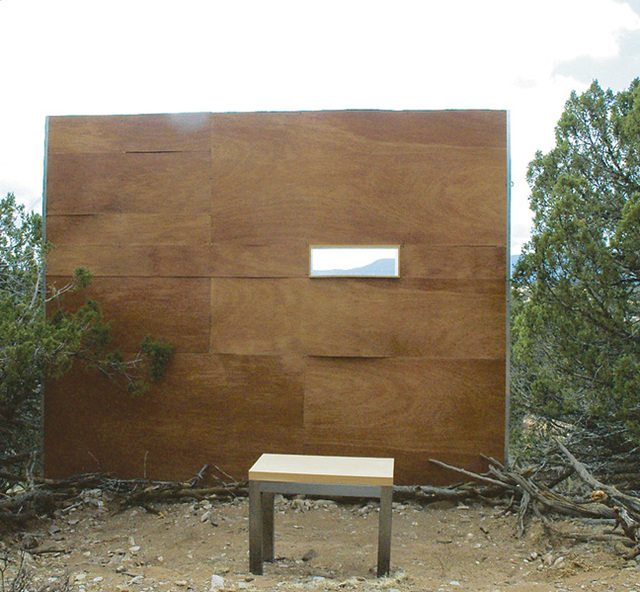Three weeks ago, my fear of flying shot to the surface as I flew out from Vermont in a twin-prop plane to New Jersey. All I could do was wait for the plane to fall from the sky and be drawn across the New York landscape in a broad hunk of industrial charcoal—or a narrow hunk, considering my vantage point. Putting my phobia aside, what I saw below was wondrous and vast and dense and thick. Yellow birch, maple, blueberries and blackberries—the landscape reeked of vegetation and dampness. It was like Bizarro-New Mexico, where every opening was filled to spilling over.Perhaps it was fortuitous that the first show I saw when I got back to Albuquerque was Take Back at THE LAND/gallery. Take Back features the work of Lea Andersson, Matt Brackbill, Beau Carey, Jess Dunn, Ryan Henel, Devin Kovach, Kate Mitchell and Erika Osborn. In essence, this show is a branch of an installation at the much larger THE LAND/an art site in Mountainair. That installation, called Given Take , came out of a proposal submitted in the form of a poem by Maine artists Constant Albertson, Susan Camp and Andrea Mauery. The eight New Mexican artists interacted with the poem to create site-specific pieces in pseudo-collaboration with the Maine artists. This may come across as a complex knot, but what’s important is that the New Mexican artists really created two shows. The first is site-specific (in Mountainair). The second is comprised of objects made specifically for the gallery (in Albuquerque).THE LAND has two faces and the goals of each are markedly different. The mission of the art site is to promote land issues, conservation and education. It is dedicated, in a way, to "land art" and artists that want to deal with the scale and material that the earth provides. The gallery, on the other hand, is knowingly chained to its gallery-ness: that rarefied space that deals specifically with materials and protrusions within architecture rather than without it.The artists selected for Given Take/Take Back are young, a fact that Erika Osborn, the show’s curator, sees as an asset. “One thing that is important to note is that land art practices have changed dramatically since the ’60s,” she wrote in an e-mail. “However, sometimes—not always, but sometimes—in the art world you will find that the dialog remains rooted there. Having a young group of artists brought some new life to land art, as a contemporary practice.”It’s unfortunate that I only saw half of this collaboration, because the work in the gallery seems like a ghost of the work 70 miles away. While the premise of the show (to make work drawn from the energy of the site-specific installations) is a conscious flip on the original impulse for taking art outside of the gallery in the ’60s, it suffers from a diminution in scale and dislocation. Ironically, what is presented in the gallery is ultimately weakened by its connection to the larger place. The unseen installations remain ideally abstract and are therefore more perfect than what’s in the gallery. Unfair, yes, but that’s the way it goes. As an example, Beau Carey’s use of chalk from the Mountainair site looks great in photos, but his addition of chalk to a painting of river rocks in the gallery doesn’t make a lot of sense formally or even from a material standpoint. It’s kind of like any lessons learned outside the gallery—lessons that could have expanded the artists’ practices—were, for the most part, forced to fit the frame of previous habits or inclinations.However, a few pieces in the gallery do step out of that shadow. Matt Brackbill’s installation in the anteroom is comprised of small etchings on glass as well as a “lightning field” of No. 2 pencils mounted on a small table. The pencils stand eraser-up, a miniature forest in perfect rows across a space that measures at least 2 feet by 3 feet. The potency of this piece lies in its complex readings. Additionally, Osborn’s viewfinder pieces, like Brackbill’s pencil piece, play off the strength of a known object or material (i.e., red plastic or Dixon Ticonderoga pencils). The small drawings inside are portable landscapes, a lucky rabbit’s foot for your eye. After I left the show, I started to think more about earthworks and land art—about scale and if that mattered anymore. I thought about trash art and Isa Genzken and David Altmejd and whether their work was a reclamation, a “take back,” too. I wondered whether a large, open site was any different than a white cube; if the intentions were the same. And these were all good questions, questions I might not have asked if THE LAND wasn’t there to put them to me.
THE LAND/gallery (419 Granite NW) presents Take Back by appointment through Sept. 5. For info, call 242-1501 or visit landartsite.org.
David Leigh is the former director of Donkey Gallery.










